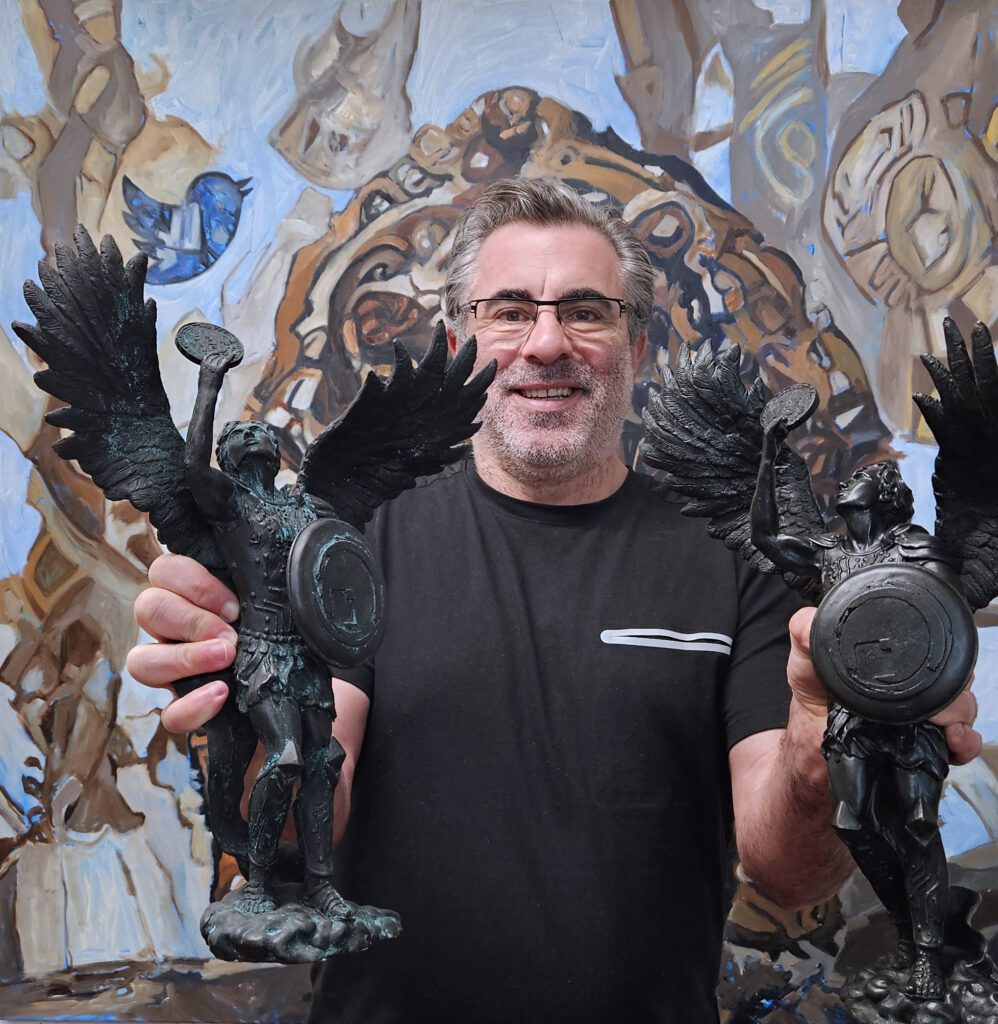Nfts
Le tribunal refuse de rejeter un recours collectif en matière de valeurs mobilières alléguant que les NFT de DraftKings sont des « valeurs mobilières » | Skadden, Arps, Slate, Meagher & Flom LLP
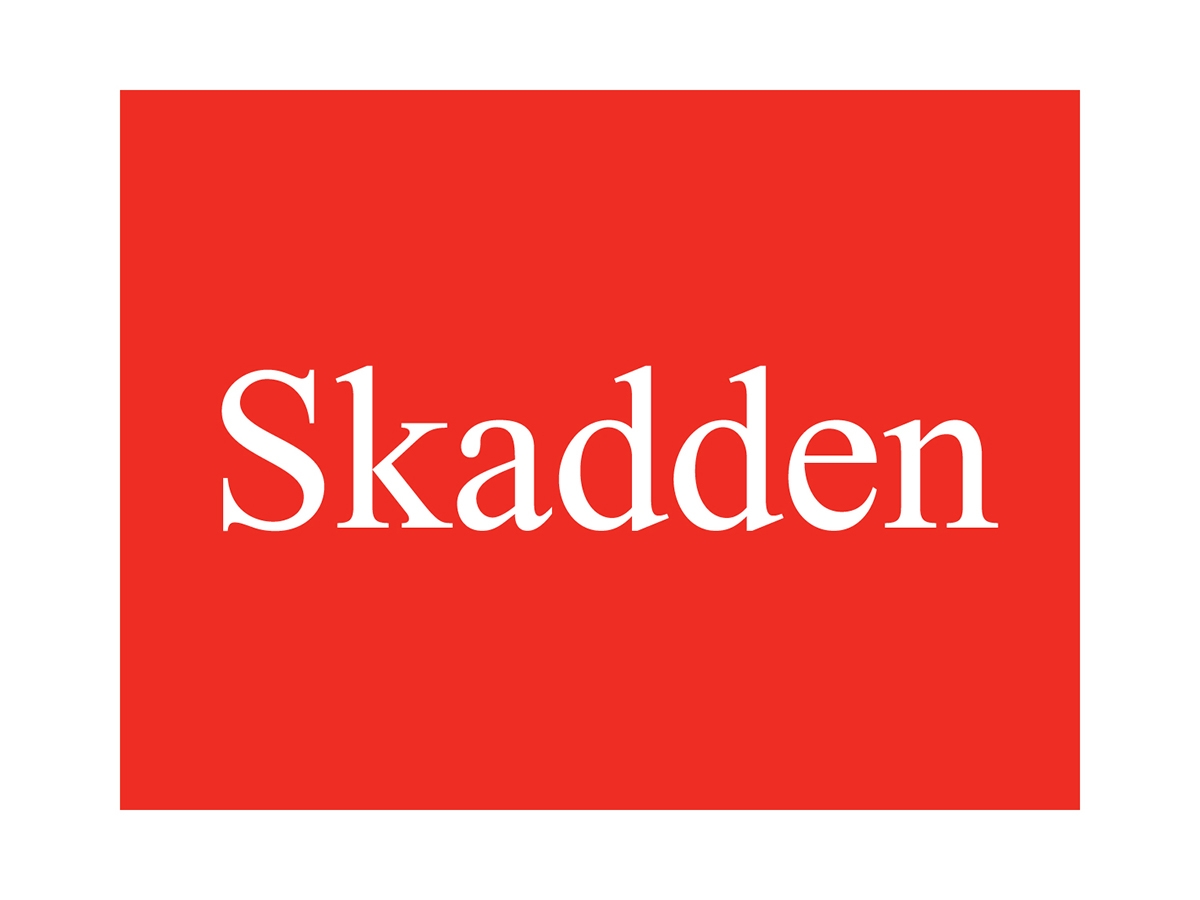
Les litiges en matière de valeurs mobilières découlant de l’achat ou de la vente de produits numériques tels que les cryptomonnaies, les jetons non fongibles (NFT) et les jetons de sécurité se sont multipliés ces dernières années. La question cruciale dans ces affaires est de savoir si le produit numérique acheté est un « titre » soumis aux lois fédérales ou étatiques sur les valeurs mobilières.
Le 2 juillet 2024, la juge Denise Casper du tribunal de district américain pour le district du Massachusetts a statué dans l’affaire Dufoe c. DraftKings, Inc. que le plaignant avait allégué de manière adéquate que les transactions dans les NFT DraftKings étaient des contrats d’investissement et donc des « titres » selon le test fondamental de la Cour suprême des États-Unis énoncé dans Howey.
Le tribunal de district a fondé cette décision sur des allégations, acceptées comme vraies au stade de la plaidoirie, selon lesquelles les ventes de NFT de DraftKings reflétaient :
- UN “entreprise commune” par le biais d’une communauté horizontale car (i) DraftKings aurait mis en commun des actifs grâce au réinvestissement des revenus générés par la vente des NFT dans son activité NFT, et (ii) les acheteurs de NFT auraient partagé les bénéfices et les risques parce que DraftKings contrôlait la « place de marché » en ligne par laquelle les NFT étaient négociés.
- UN « attente raisonnable de profits provenant uniquement des efforts d’autrui » sur la base de prétendues déclarations promotionnelles de DraftKings sur les perspectives d’investissement présentées par les NFT et parce que la valeur des NFT dépendrait prétendument du succès de la « place de marché » de DraftKings.
L’affaire Dufoe est seulement la deuxième affaire dans laquelle un tribunal se penche sur la question de savoir si les ventes de NFT peuvent constituer des titres au sens de Howey. En 2023, le juge Victor Marrero du tribunal de district américain du district sud de New York a statué dans l’affaire Friel c. Dapper Labs, Inc. qu’une plainte alléguait à juste titre que la vente de NFT Top Shot Moments de la National Basketball Association (NBA) constituait des contrats d’investissement. Le tribunal de Friel a reconnu que cette conclusion était « serrée ».
Bien que Dufoe et Friel fournissent un cadre pour analyser les transactions NFT selon Howey, aucune de ces décisions ne préjuge du résultat des affaires futures – ni même des affaires devant les tribunaux sur la base d’un dossier factuel complet.1 Au contraire, les deux tribunaux ont clairement indiqué que leurs conclusions respectives étaient étroites, dépendantes des faits et motivées par des allégations spécifiques qui pouvaient être contestées lors d’un jugement sommaire ou d’un procès.
Arrière-plan
DraftKings est une société de divertissement sportif numérique et de jeux. En août 2021, DraftKings a commencé à vendre des NFT via la DraftKings Marketplace (la Marketplace), une plateforme en ligne détenue et exploitée par DraftKings. En février 2022, DraftKings a lancé ce que l’on appelle les « NFT gamifiés ». Les propriétaires de NFT gamifiés pouvaient utiliser leurs NFT dans des concours « Reignmakers » pour gagner des prix en espèces. Les NFT DraftKings ont été créés sur la blockchain Polygon qui existe indépendamment de DraftKings.
Les propriétaires de NFT DraftKings pourraient revendre leurs NFT sur la Marketplace DraftKings. Les propriétaires pourraient également potentiellement vendre leurs NFT en dehors de la Marketplace. Mais pour effectuer une vente hors Marketplace, le propriétaire doit d’abord transférer le NFT de la Marketplace vers son portefeuille numérique personnel, et DraftKings aurait conservé le « pouvoir discrétionnaire exclusif » d’autoriser ou d’interdire un tel transfert.
DraftKings aurait fait la promotion des NFT, notamment via une salle de discussion en ligne et sur les réseaux sociaux.
Le plaignant, un acheteur présumé de NFT DraftKings, a intenté une action collective putative contre DraftKings et plusieurs de ses dirigeants, alléguant que (i) les NFT DraftKings constituaient des titres non enregistrés et (ii) les défendeurs exploitaient une bourse de valeurs non enregistrée. Le plaignant a fait valoir des réclamations pour des violations présumées des articles 5, 12(a)(1) et 15 de la Securities Act de 1933 ; des articles 5, 15(a)(1), 20 et 29(b) de la Securities Exchange Act de 1934 ; et du chapitre 110A, articles 201(a) et 301 des lois générales du Massachusetts.
La décision de la Cour
Les défendeurs ont demandé le rejet de la plainte dans son intégralité au motif que les NFT DraftKings ne sont pas des « titres » soumis aux lois fédérales ou du Massachusetts sur les valeurs mobilières. Le tribunal a rejeté la requête, estimant que le plaignant avait suffisamment plaidé que les NFT DraftKings étaient des « titres » au sens de Howey sur la base des faits allégués dans la plainte, acceptés comme vrais aux fins de la requête.
La Cour a appliqué la norme établie dans l’arrêt Howey il y a plus de 75 ans pour évaluer si une transaction constitue un contrat d’investissement et donc une « valeur mobilière » soumise aux lois et exigences fédérales en matière de valeurs mobilières. Selon l’arrêt Howey, un contrat d’investissement existe lorsqu’une personne (i) « investit son argent » (ii) « dans une entreprise commune » et (iii) « est amenée à espérer des profits uniquement grâce aux efforts du promoteur ou d’un tiers ».
Les défendeurs n’ont pas contesté le premier élément – l’investissement d’argent – au stade de la plaidoirie. Le tribunal a jugé que le demandeur avait suffisamment plaidé les faits pour étayer les deux autres éléments :
Entreprise commune. Un plaignant peut invoquer une entreprise commune par le biais d’une « communauté horizontale », ou d’une mise en commun d’actifs provenant de plusieurs investisseurs de telle manière que tous partagent les bénéfices et les risques de l’entreprise. Le tribunal a reconnu que, en ce qui concerne les NFT – contrairement à d’autres formes de produits numériques – « il est moins évident que les risques et les bénéfices soient partagés entre tous les investisseurs car chaque NFT est par définition unique ou non fongible ». Le tribunal a néanmoins estimé que le plaignant avait plaidé de manière adéquate que tous les acheteurs de NFT de DraftKings partageaient les risques et les bénéfices de « l’entreprise ». Le tribunal s’est appuyé sur des allégations selon lesquelles DraftKings réinvestissait les revenus générés par la vente de NFT DraftKings dans son activité, notamment aux fins de promouvoir la place de marché contrôlée par DraftKings sur laquelle les NFT étaient négociés. De plus, la valeur des NFT dépendait prétendument de la place de marché. Le tribunal a noté : « si DraftKings fermait la place de marché ou si l’intérêt pour la place de marché s’évaporait, la valeur des NFT tomberait vraisemblablement à zéro ».
Espérance raisonnable de profits provenant uniquement des efforts d’autrui. Pour invoquer une attente raisonnable de profits provenant uniquement des efforts d’autrui, un plaignant doit alléguer des faits à l’appui de deux exigences indépendantes.
Premièrement, le plaignant doit faire valoir une attente raisonnable de profits. Le tribunal a estimé que le plaignant répondait à cette norme sur la base des déclarations faites par DraftKings et les défendeurs individuels au sujet des NFT. Ces déclarations comprenaient, par exemple, des détails sur l’historique des transactions des NFT DraftKings, des informations sur les « plus grandes hausses et baisses » au sein de la Marketplace et des proclamations selon lesquelles les acheteurs « conserveraient le profit du marché libre de vos cartes ». Le tribunal s’est également appuyé sur des allégations selon lesquelles le public considérait les NFT DraftKings comme un investissement, par exemple par le biais de correspondances dans des salles de discussion comparant la Marketplace au marché boursier et discutant des moyens de gagner de l’argent en négociant des NFT DraftKings.
Deuxièmement, un plaignant doit alléguer que l’attente de profits d’un acheteur dépend des efforts d’autrui. Le tribunal a accepté les allégations du plaignant selon lesquelles les NFT dépendaient du succès de la Marketplace et donc de DraftKings, même si les NFT n’étaient pas créés sur une blockchain propriétaire de DraftKings. Le tribunal a estimé qu’« il est plausible que les utilisateurs n’aient pas retiré, et n’aient peut-être pas pu retirer, leurs NFT du système de DraftKings et les aient placés dans leurs propres portefeuilles ». De plus, DraftKings aurait déployé des efforts considérables pour promouvoir la Marketplace et les NFT.
Les implications pratiques
Dufoe suit en grande partie le raisonnement de Friel, mais avec une variante : dans l’affaire Friel, le défendeur, Dapper Labs, était accusé de contrôler la « Flow Blockchain » sur laquelle les NFT NBA Top Shot Moments étaient négociés. Cette allégation était au cœur de la décision du tribunal selon laquelle le plaignant avait suffisamment plaidé la communauté horizontale et une attente raisonnable de profits provenant des efforts d’autrui.
Dans l’affaire Dufoe, en revanche, les NFT de DraftKings étaient négociés sur la blockchain Polygon qui « existe indépendamment de DraftKings » et qui n’est pas contrôlée par DraftKings. Le tribunal de Dufoe a estimé qu’il s’agissait d’une distinction sans différence aux fins de l’affaire Howey, car le plaignant a allégué de manière plausible que toutes les transactions avaient lieu via la Marketplace et que DraftKings pouvait interdire les transactions en dehors de la Marketplace à sa seule discrétion.
Les décisions de Dufoe et Friel ne sont pas les seules à déterminer si les ventes de NFT constituent des valeurs mobilières soumises aux lois sur les valeurs mobilières. Ces deux décisions sont susceptibles d’appel devant les tribunaux de district. En outre, les décisions reposent sur des allégations factuelles spécifiques à chaque cas qui pourraient être réfutées lors d’un jugement sommaire ou d’un procès.
En effet, le tribunal de l’affaire Dufoe a commencé son analyse en observant qu’il « n’a pas besoin de décider si toutes les transactions NFT doivent être considérées comme un contrat d’investissement ». Le tribunal doit plutôt « évaluer[d] La question n’est pas seulement de savoir si Dufoe a allégué de manière plausible que les NFT de DraftKings dans le contexte de la place de marché sont des valeurs mobilières. » Le tribunal de Friel a également lié sa décision aux faits allégués et a noté que chaque projet NFT « doit être évalué au cas par cas ».
Dufoe a également répertorié les différends factuels qu’elle n’a pas pu résoudre au stade de la plaidoirie et qui pourraient modifier l’analyse de Howey sur la base d’un dossier factuel complet, comme les allégations des défendeurs selon lesquelles :
- DraftKings a mélangé des fonds NFT avec son « vaste trésor d’autres revenus », ce qui contredit l’affirmation du plaignant selon laquelle il y avait une mise en commun d’actifs suffisante pour établir une communauté horizontale.
- Les prix des NFT de DraftKings n’ont pas évolué en tandem et dépendaient plutôt d’autres facteurs spécifiques à un NFT donné, réfutant l’affirmation du plaignant selon laquelle tous les utilisateurs partageaient les risques et les bénéfices de l’entreprise suffisamment pour établir une communauté horizontale. Le tribunal a observé que «[a]À un stade ultérieur du litige, DraftKings aura la possibilité de présenter des preuves montrant que les investisseurs « pourraient réaliser des bénéfices ou subir des pertes indépendamment de la fortune des autres acheteurs » et ainsi nier la communauté horizontale.
- Les défendeurs ne contrôlaient en réalité pas le marché primaire et secondaire de leurs NFT, car les utilisateurs pouvaient effectuer des transactions en dehors de la place de marché.
- Les attentes de profit du plaignant étaient déraisonnables ou motivées par une intention de consommation (par exemple, la participation aux concours Reignmakers). Le tribunal a reconnu que DraftKings avait abaissé le prix des NFT au fil du temps, ce qui contredisait une attente de profit, et que la plainte faisait état d’« au moins un motif mixte de consommation et de spéculation de la part des acheteurs de NFT ». Mais le tribunal a conclu que « ces questions ne sont pas susceptibles d’être résolues dans le cadre d’une requête en rejet, où toutes les conclusions plausibles sont tirées en faveur de [the plaintiff].”
_______________________
1 Les parties à l’affaire Friel ont conclu un accord de règlement avant la fin de la procédure de communication préalable et de la procédure de jugement sommaire. Le règlement est soumis à l’approbation finale du tribunal.
[View source.]
Nfts
NFTs Maintain Upward Momentum, Sales Volume Surpasses $107 Million
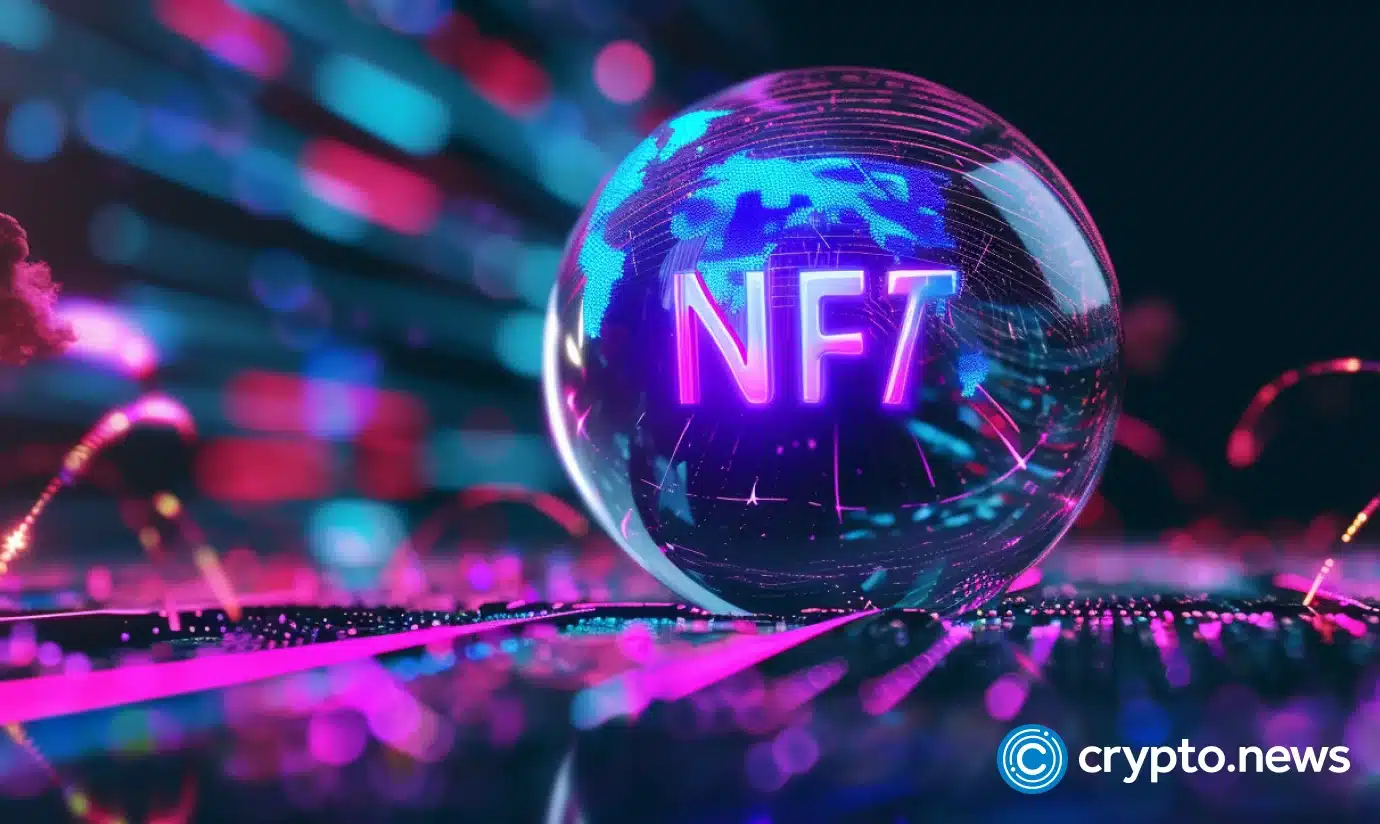
Non-fungible tokens, or NFTs, saw sales volume surge for the second week in a row, reaching $107 million, an increase of 8.5%.
A substantial increase in the number of NFT Buyers accompanied this growth, reaching 488,141 — a staggering increase of 89.56%.
On the other hand, the number of NFT sellers also increased by 69.8%, totaling 198,450, signaling an improved business environment and increased market engagement.
Below is a look at what happened in the NFT market over the past week.
Ethereum Maintains Leading Position While Solana and Bitcoin Follow
Blockchains by weekly NFT sales volume | Source: CryptoSlam
Over the past few weeks, Ethereum (ETH) continued to dominate the NFT market with $36.6 million in total sales, driven by 35,236 buyers, a 46.31% increase from the previous week.
Solana (GROUND) has emerged as a serious competitor, recording total revenue of $26.15 million, thanks to a substantial 114.07% increase in the number of buyers.
Bitcoin (Bitcoin) The NFT market also saw a notable surge, with total sales reaching $21.4 million, thanks to a staggering 222.29% increase in buyers.
Polygon (MATICS), which had the second best performance the previous week, saw its total sales volume drop by more than 15%, dropping it to 4th place just ahead of Immutable (IMX).
Other notable performances were achieved by Zora and Blast, which recorded the two largest percentage increases in sales volume, at 463% and 227% respectively.
Best Collections: Solana Monkey Business Shines
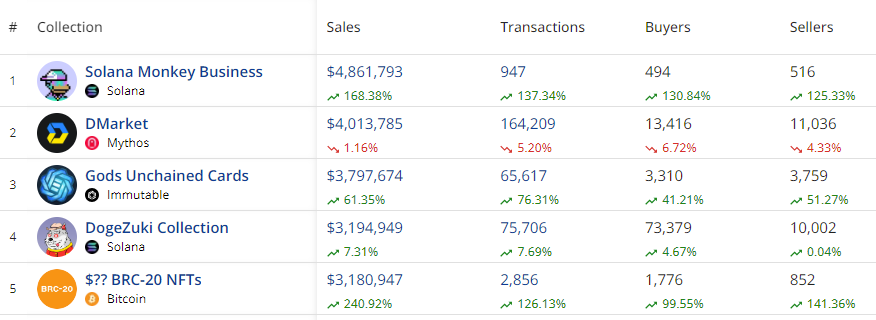 Ranking NFT collections by weekly sales volume | Source: CryptoSlam
Ranking NFT collections by weekly sales volume | Source: CryptoSlam
Among the top NFT collections, Solana Monkey Business came out on top with $4.86 million in sales, an increase of 168.38%. The collection also saw a significant increase in transactions (137.34%) and buyers (130.84%).
The DMarket collection on the Mythos blockchain, which recorded $4.01 million in sales, came in a close second. Interestingly, this is the only collection among the top 5 by sales volume to see a decline in the number of transactions and buyers.
Immutable’s Gods Unchained cards also made headlines with $3.8 million in sales, an increase of 61.35%. This collection saw notable growth in both transactions (76.31%) and buyers (41.21%), a testament to the growing popularity of blockchain-based trading cards.
Best-Selling NFTs and Fan Tokens
In terms of individual sales, Ethereum’s Autoglyphs #167 led with a sale of $274,561, followed by Bitcoin’s Protoshrooms with $148,574. Other notable sales included BNB’s kNFT: Locked kUSDT and Arbitrum’s Umoja Synths, highlighting the diversity and breadth of the NFT market across different blockchains.
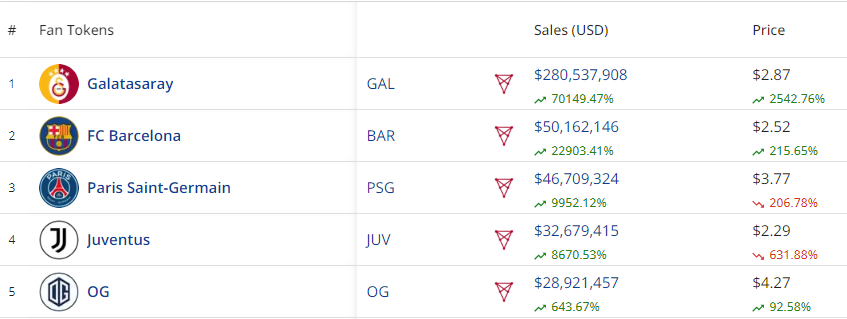 Top 5 Fan Tokens by Sales Volume
Top 5 Fan Tokens by Sales Volume
As can be seen in the table above CryptoSlamFan tokens also continued to see explosive growth, with Galatasaray’s token on the Chiliz blockchain recording a turnover of $280.5 million. This reflects an increase of 70149.47%.
FC Barcelona and Paris Saint-Germain followed with substantial sales volumes, indicating the growing popularity of sports-related NFTs.
Market consequences
The latest performance of the NFT market marks a significant turnaround, demonstrating resilience and renewed investor interest after a period of declining sales volumes.
This is the second consecutive week of improved sales, suggesting a potential upward trend. It is worth noting that this resurgence comes amid a broader recovery in the cryptocurrency market, which is currently valued at $2.55 trillion.
Major cryptocurrencies like Bitcoin, Ethereum, BNB, and Solana have all registered Prices have risen by double digits over the past week, further fueling optimism in the digital asset sector.
The correlation between rising cryptocurrency prices and the recovery of the NFT market could be an indication of strengthening investor confidence, setting a positive tone for the coming weeks.
Nfts
APENFT’s One-Day Trading Volume Hits $16.67 Million (NFT)

APENFT (NFT) fell 0.3% against the U.S. dollar in the 24-hour period ending at 9:00 a.m. ET on July 21. APENFT has a market cap of $8.54 million and $16.67 million worth of APENFT was traded on exchanges over the past day. Over the past week, APENFT has been trading 3.1% lower against the US Dollar. One APENFT token can now be purchased for around $0.0000 or 0.00000000 BTC on major cryptocurrency exchanges.
Here’s how other cryptocurrencies performed over the past day:
- KILT Protocol (KILT) is up 1.9% against the dollar and is now trading at $0.20 or 0.00000302 BTC.
- Aidi Finance (BSC) (AIDI) fell 2.2% against the dollar and is now trading at $0.0000 or 0.00000000 BTC.
- Zoo Token (ZOOT) fell 2.2% against the dollar and is now trading at $0.0652 or 0.00000239 BTC.
- CareCoin (CARES) fell 2.2% against the dollar and is now trading at $0.0809 or 0.00000297 BTC.
- Kitty Inu (KITTY) rose 1.9% against the dollar and is now trading at $95.84 or 0.00338062 BTC.
- Hokkaidu Inu (HOKK) rose 1.2% against the dollar and is now trading at $0.0004 or 0.00000001 BTC.
- Jeff in Space (JEFF) fell 2.2% against the dollar and is now trading at $2.75 or 0.00010076 BTC.
- Lumi Credits (LUMI) fell 0.7% against the dollar and is now trading at $0.0128 or 0.00000019 BTC.
- AXIA Coin (AXC) fell 0.1% against the dollar and is now trading at $13.43 or 0.00048094 BTC.
About APENFT
APENFT launched on March 28, 2021. The total supply of APENFT is 999,990,000,000,000 tokens and its circulating supply is 19,999,800,000,000 tokens. The official website of APENFT is apenft.orgThe official APENFT Twitter account is @apenftorg and his Facebook page is accessible here.
According to CryptoCompare, “APENFT is a blockchain-based platform created by the APENFT Foundation to create, buy, sell, and trade non-fungible tokens (NFTs) on the TRON and Ethereum networks. It allows for the ownership and trading of unique digital assets such as artwork, music, videos, and more. It also provides tools for artists and creators to create and promote their own NFTs, as well as participate in community events and governance.”
APENFT Token Trading
It is not currently generally possible to purchase alternative cryptocurrencies such as APENFT directly using US dollars. Investors wishing to acquire APENFT must first purchase Ethereum or Bitcoin using an exchange that deals in US dollars such as CoinbaseGDAX or Gemini. Investors can then use their newly acquired Ethereum or Bitcoin to purchase APENFT using any of the exchanges listed above.
Receive daily news and updates from APENFT – Enter your email address below to receive a concise daily summary of the latest news and updates for APENFT and associated cryptocurrencies with FREE CryptoBeat Newsletter from MarketBeat.com.
Nfts
Next US Vice President JD Vance Holds Bitcoin and NFTs, Expected to Boost MATIC and Algotech Post-Election

The blockchain technology landscape is about to transform as JD Vance, the likely next US vice president, emerges as a strong advocate for digital assets. Recent reports suggest that Vance not only holds Bitcoin (BTC) and NFTs, but is also willing to back promising blockchain initiatives like Polygon (MATIC) and Algotech (ALGT) post-elections.
JD Vance’s Cryptocurrency Investments Highlight Shift in Government Perspective
U.S. Senator JD Vance has garnered considerable attention for his recent investments in Bitcoin (BTC) and NFTs. Public records indicate that he owns between $100,000 and $250,000 worth of Bitcoin (BTC), indicating considerable interest in the success of the cryptocurrency market. This level of financial commitment from a high-profile government figure is unprecedented and underscores the growing credibility and promise of digital assets.
JD Vance’s interests extend beyond Bitcoin (BTC) to non-fungible tokens (NFTs), with reports suggesting his involvement in acquiring notable pieces from renowned collections. While the details of his NFT portfolio remain unknown, those who know the senator confirm his foray into this field.
This exploration of NFTs underscores Vance’s openness to exploring innovative and artistic applications of blockchain technology beyond cryptocurrencies’ typical role as assets or means of exchange. Vance’s involvement with cryptocurrency stands in stark contrast to the views of many of his peers in Congress, who often express doubt or hostility toward digital currency.
His direct involvement as an investor and user of these technologies gives him a unique perspective on their potential benefits and drawbacks. This practical understanding is likely to influence his stance on policy and regulation should he take on the role of vice president.
Polygon (MATIC) Hits $0.53, Eyes Breakout Amid Market Slowdown
The Vance administration, known for its support for cryptocurrencies, could significantly boost Polygon (MATIC), a major Ethereum layer 2 scaling project. MATIC has already attracted the attention of the developer community for its innovative solutions.
Even so, regulatory uncertainties have slowed widespread adoption and integration with traditional financial systems. Vance’s backing could serve as a driving force to unlock Polygon’s untapped capabilities.
A recent look at the MATIC token shows that its current trading value is $0.53, which represents an increase of over 2% in the last 24 hours. This surge coincides with a downturn in the broader cryptocurrency market, signaling solid fundamental strength and a growing sense of confidence among investors regarding Polygon’s future prospects.
Based on technical indicators, MATIC appears to be facing a resistance level that has persisted for several months, hinting at a potential breakout that could propel prices towards the previous peak around $1.29.
MATIC’s cutting-edge technology has taken a significant leap forward with the introduction of the Plonky3 zero-knowledge proof system. This innovation in zk-rollup technology is set to revolutionize MATIC’s scalability and efficiency, cementing its position as the premier choice for developers and enterprises.
Algotech (ALGT) Eyes $1 Price Hike When Its Exchange Launches
Algotech, a project that has attracted the interest of crypto enthusiasts and JD Vance, aims to transform algorithmic trading in the cryptocurrency space. Through the use of artificial intelligence and machine learning, Algotech offers advanced trading strategies to ordinary investors.
The platform’s innovative approach and ambitious roadmap are in line with JD Vance’s goal of driving financial innovation and making sophisticated investment tools more accessible to all. Algotech’s decentralized structure stands out, aligning perfectly with the core principles of blockchain technology.
By cutting out the middleman and giving users direct authority over their trading algorithms, Algotech embodies the essence of financial independence advocated by many in the crypto community, including Vance. This common ground makes Algotech a natural choice for endorsement by crypto-friendly leadership.
As Algotech’s pre-sale gains momentum, with over $9.6 million in funding, excitement is building for its official launch. Analysts have set lofty price targets, with some even suggesting that ALGT could surge to $1 shortly after it goes public.
While it’s wise to approach these predictions with caution, the combination of Algotech’s cutting-edge technology and the potential backing of key figures like JD Vance could pave the way for significant growth and adoption.
Learn more:
Disclaimer: This is a paid release. The statements, views, and opinions expressed in this column are solely those of the content provider and do not necessarily represent those of Bitcoinist. Bitcoinist does not guarantee the accuracy or timeliness of any information available in this content. Do your research and invest at your own risk.
Nfts
OG Crypto Artist Trevor Jones Unveils Groundbreaking Collection of Ordinals | NFT CULTURE | NFT News | Web3 Culture
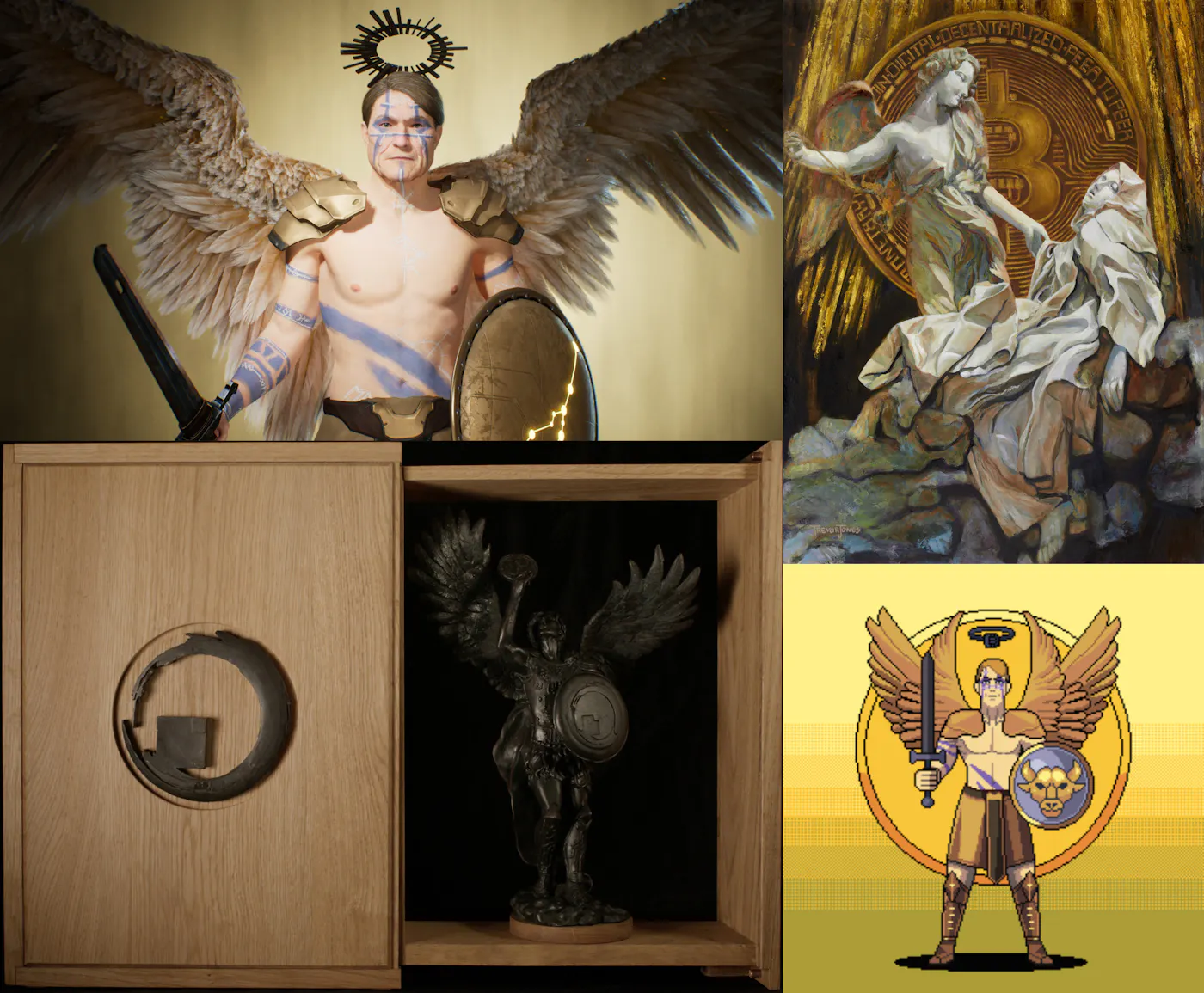
Trevor Jones’ New Genesis BTC Collection: CryptoAngels
Known for his innovative blend of physical and digital art, Trevor Jones continues to push the boundaries of the NFT space with his latest collection, CryptoAngels. Since his foray into Bitcoin-themed artwork in 2017, Jones has garnered a significant following, cementing his reputation with record-breaking sales and community events.
The Bitcoin Angel Journey
In 2021, Jones made headlines with his Bitcoin Angel open edition, selling 4,158 editions for an incredible $3.2 million in just seven minutes. This success paved the way for his latest venture, where he combines art, community, and technology in new ways. His annual Castle Parties, celebrating art, culture, and charity, have further cemented his place in the Web3 world.
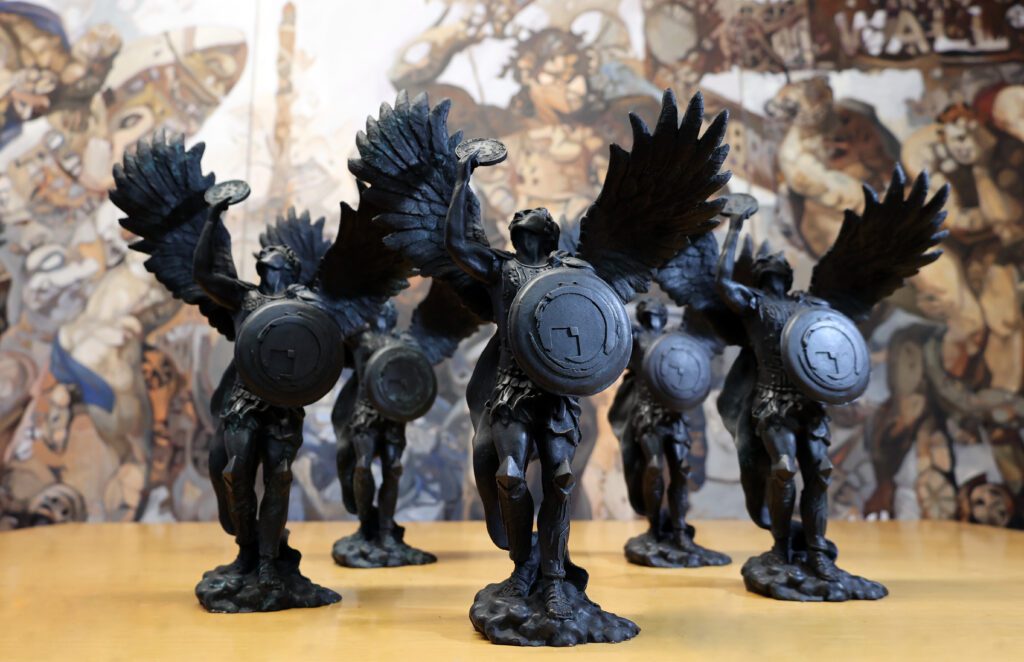
CryptoAngels Collection Review
Jones’ CryptoAngels collection is divided into two main stages: Archangels and CryptoAngels.
- Step 1: The Archangels The initial phase, Archangels, saw 21 collector’s packages sold for 87.9 ETH (approximately $335,291). Each package included:
- A physical bronze sculpture of the Bitcoin angel
- A 3D NFT avatar
- An Archangel Ordinal
Esteemed collectors like ModeratsArt, Batsoupyum, Bharat Krymo, Blondie23LMD, and 1Confirmation now lead the CryptoAngel army as Archangel Collectors.
- Step 2: CryptoAngels The second phase, set to launch on August 7, features 7,777 unique CryptoAngels. These will be available for minting via OrdinalsBot, starting with a whitelisting phase. Each CryptoAngel is distinct and named by Jones himself. The collection is organized into 21 cohorts, each associated with one of Archangel’s collectors, fostering sub-communities within the larger collection. Additionally, there are seven 1/1 CryptoAngels, making them exceptionally rare and not aligned with a cohort.
Connecting Bitcoin and Art
Jones, who has been a strong Bitcoin supporter since mid-2017, expresses his deep connection to the crypto community. He sees the CryptoAngels collection as a tribute to that community, bringing his iconic Bitcoin Angel motif to the blockchain.
“I have been personally investing in Bitcoin since mid-2017 and its ethos quickly inspired me in my crypto art journey. I have followed the growth of Ordinals since its inception and the CryptoAngels collection is my offering to a community that has welcomed me with open arms and given me the opportunity to bring my Bitcoin Angel motif to the chain where it was always meant to be,” said artist Trevor Jones.
Collectors’ opinions
“Bitcoin’s OG artist Trevor Jones, behind the Bitcoin Angels depositing ordinals on the immutable chain is a match made in crypto-native art heaven.” – Bharat Krymo (@krybharat – Archangel Collector)
“The 2018 Bitcoin Angel oil painting is one of the first crypto tributes to Bitcoin, so CryptoAngels on Ordinals is a natural extension of Trevor’s artistic journey” – batsoupyum (Archangel Collector)
Interactive experience and limited editions
Rounding out the collection, 21 special Angels will be available to mint for $7 each on Base, playable in the exclusive retro arcade game, Dante’s Pixel Inferno. The game challenges players to guide their Angel through the nine circles of Fiat Hell, collecting Bitcoin and earning rewards. Each Angel in the game has unique abilities and weapons.
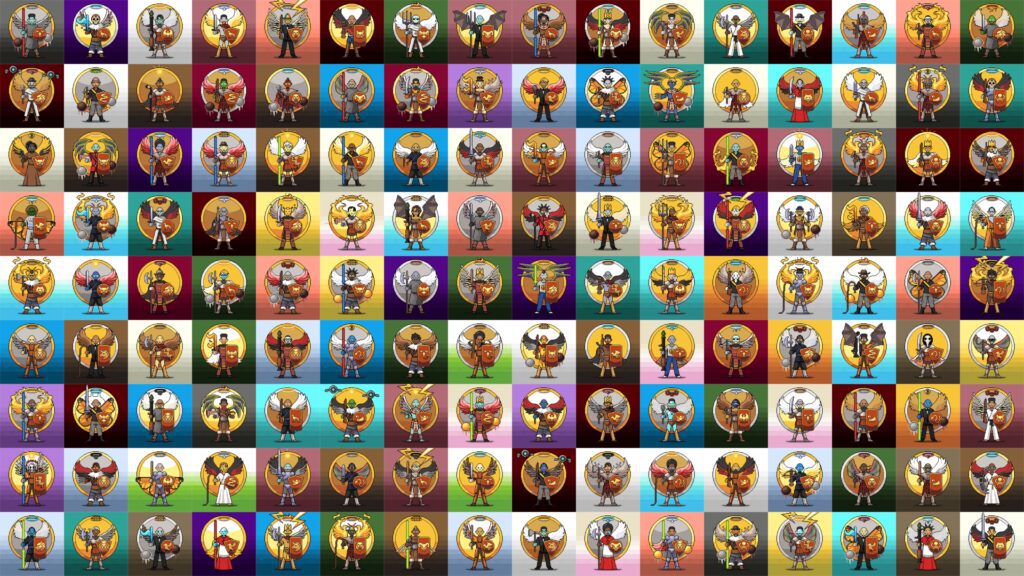

Whitelisting Opportunities and Community Engagement
Whitelisting (WL) opportunities are available through community partnerships, existing Bitcoin Angel OE and Trevor’s Ascended Angels holders, and weekly giveaways. To stay up to date and secure a spot on the whitelist, join Trevor Jones’ active Discord community.
TL;DR
Trevor Jones is launching the CryptoAngels collection on August 7th, building on his Bitcoin Angel legacy. Split into two stages, Archangels and CryptoAngels, the collection includes unique NFTs and physical artworks, fostering strong community connections. Exclusive gaming experiences and limited minting opportunities enhance engagement. Join the Discord for your chance to win.
-
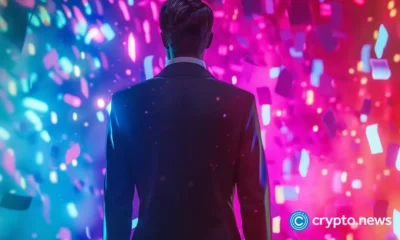
 Nfts12 months ago
Nfts12 months agoShardLab Launches ZK-Based Tool for Digital Identity and NFT Vouchers
-
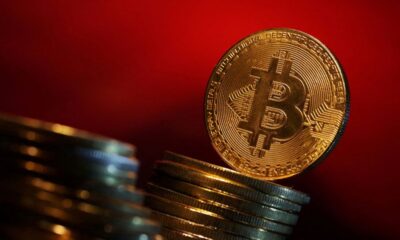
 News1 year ago
News1 year agoWallet recovery firms are abuzz as stranded cryptocurrency investors panic in the bitcoin boom
-

 Bitcoin12 months ago
Bitcoin12 months agoBitcoin, Ethereum, Solana and Cryptocurrency Markets Look Ready to ‘Send’ as Stars Align, According to Investor Chris Burniske
-
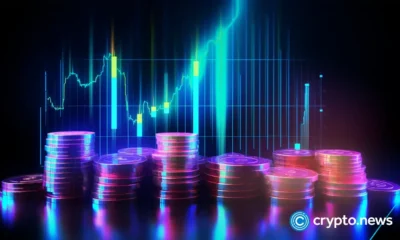
 Altcoins11 months ago
Altcoins11 months agoThree Altcoins Poised for Significant Growth in 2024: ETFS, OP, BLAST
-
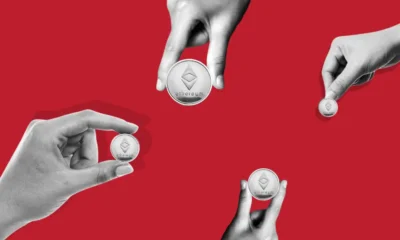
 Altcoins11 months ago
Altcoins11 months agoAccumulate these altcoins now for maximum gains
-
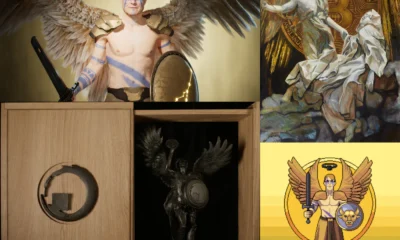
 Nfts12 months ago
Nfts12 months agoOG Crypto Artist Trevor Jones Unveils Groundbreaking Collection of Ordinals | NFT CULTURE | NFT News | Web3 Culture
-

 Bitcoin12 months ago
Bitcoin12 months agoBillionaires are selling Nvidia stock and buying an index fund that could rise as much as 5,655%, according to some Wall Street analysts
-
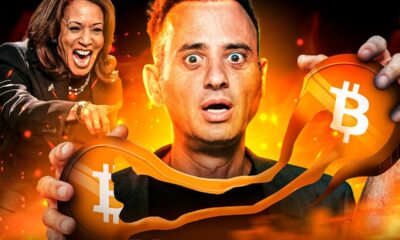
 Videos8 months ago
Videos8 months agoKamala just won the boner! [Bad For Crypto]
-
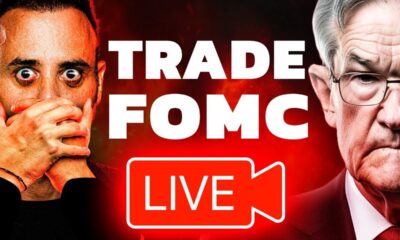
 Videos1 year ago
Videos1 year agoLIVE FOMC 🚨 Could be CATASTROPHIC for Altcoins!
-

 Videos1 year ago
Videos1 year agoSTOCK MARKET FUD! ⚠️ [Why This Is GREAT For Bitcoin Traders!]
-

 Videos1 year ago
Videos1 year agoAttention: a historically significant BITCOIN signal has just appeared!
-

 News1 year ago
News1 year agoA Guide for Newcomers & Beginners – Forbes Advisor

